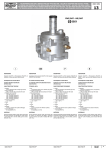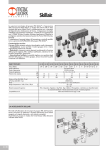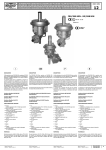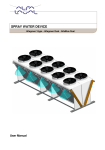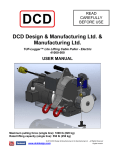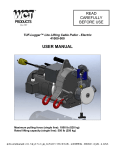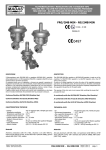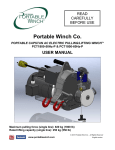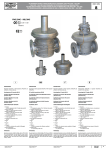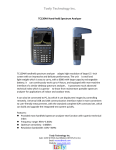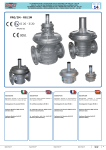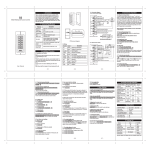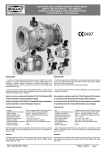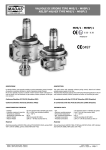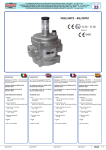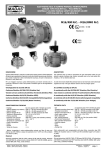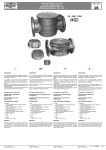Download FRG/2MC - RG/2MC
Transcript
MADAS FILTROREGOLATORI e REGOLATORI GAS A CHIUSURA TIPO FRG/2MC - RG/2MC (P.max 1 bar) ® FRG/2MC - RG/2MC GAS PRESSURE FILTER REGULATORS and REGULATORS (P. max 1 bar) © 2004 MADAS s.r.l. FRG/2MC - RG/2MC II 2G - II 2D MADAS-03 0051 0497 DESCRIZIONE DESCRIPTION Regolatore (RG/2MC) o filtroregolatore (FRG/2MC) di pressione a chiusura per gas. Gas pressure closing regulator (RG/2MC) or filter regulator (FRG/2MC). Omologazione CE secondo EN 88 EC certified according to EN 88 Conforme Direttiva 90/396/CEE (Direttiva Gas) In conformity with the 90/396/EEC Directive (Gas Directive) Conforme Direttiva 97/23/CE (Direttiva PED) In conformity with the 97/23/EC Directive (PED Directive) Conforme Direttiva 94/9/CE (Direttiva ATEX) In conformity with the 94/9/EC Directive (ATEX Directive) CARATTERISTICHE TECNICHE TECHNICAL DATA - Impiego - Temperatura ambiente - Temperatura superficiale max - Pressione max di esercizio - Classe - Gruppo - Attacchi filettati - Attacchi flangiati PN 16 - Use - Environment temperature - Max. superficial temperature - Max. working pressure - Class - Group - Threaded connections - Flanged connections PN 16 : Gas non aggressivi delle 3 famiglie (gas secchi) : -15 ÷ +60 °C : 60 °C : 1 bar :A :2 : (DN 15 ÷ DN 50) secondo ISO 7/1 : (DN 65 ÷ DN 100) secondo ISO 7005 : Not aggressive gases of the 3 families (dry gases) : -15 ÷ +60 °C : 60 °C : 1 bar :A :2 : (DN 15 ÷ DN 50) according to ISO 7/1 : (DN 65 ÷ DN 100) according to ISO 7005 Materiali Materials Alluminio pressofuso (UNI EN 1706), alluminio 11S (UNI 9002-5), ottone OT-58 (UNI EN 12164), acciaio zincato e acciaio INOX 430 F (UNI EN 10088), gomma antiolio NBR (UNI 7702), ovatta sintetica. Die-cast aluminium (UNI EN 1706), 11S aluminium (UNI 9002-5), OT-58 brass (UNI EN 12164), galvanized and 430 F stainless steel (UNI EN 10088), NBR rubber (UNI 7702), synthetical wadding. MADAS - Manuale Tecnico 2004 - Edizione 1 MADAS - 2004 Technical Manual - Ediction 1 FRG/2MC - RG/2MC Capitolo 21 / Chapter 21 pag. 1 MADAS FILTROREGOLATORI e REGOLATORI GAS A CHIUSURA TIPO FRG/2MC - RG/2MC (P.max 1 bar) ® FRG/2MC - RG/2MC GAS PRESSURE FILTER REGULATORS and REGULATORS (P. max 1 bar) © 2004 MADAS s.r.l. fig. 1 - Attacchi filettati fig. 1 - Threaded connections 1 2 3 4 5 6 7 8 9 10 11 12 13 14 15 16 17 18 19 20 21 22 23 24 25 26 - Tappo alluminio - Vite di regolazione - Molla di taratura - Imbuto - Rosetta dentata - Membrana di sicurezza - Viti di fissaggio imbuto - Flangia - Perno centrale - Corpo - Organo filtrante - Presa di pressione - Rondella di tenuta - Fondello - Viti di fissaggio fondello - O-Ring di tenuta fondello - Otturatore - Sede di tenuta - Tubetto sensore - Membrana di compensazione - Disco superiore per membrana - Membrana di funzionamento - Disco inferiore per membrana - Tappo antipolvere - Dado centrale - Rondella per molla MADAS - Manuale Tecnico 2004 - Edizione 1 MADAS - 2004 Technical Manual - Ediction 1 codice filtroregolatore codice regolatore attacchi filter regulator code regulator code connections FC03 RC03 DN 20 FC04 RC04 DN 25 FC05 RC05 DN 32 FC06 RC06 DN 40 FC07 RC07 DN 50 1 - Aluminium cap 2 - Regolation screw 3 - Setting spring 4 - Funnel 5 - Toothed washer 6 - Safety diaphragm 7 - Funnel fixing screws 8 - Flange 9 - Central pin 10 - Body 11 - Filtering organ 12 - Pressure tap 13 - Seal washer 14 - Bottom 15 - Bottom fixing screws 16 - Bottom seal O-Ring 17 - Obturator 18 - Seal seat 19 - Sensor tube 20 - Compensation diaphragm 21 - Diaphragm upper disc 22 - Working diaphragm 23 - Diaphragm lower disc 24 - Antidust cap 25 - Central nut 26 - Washer for spring FRG/2MC - RG/2MC Capitolo 21 / Chapter 21 pag. 2 MADAS ® © 2004 MADAS s.r.l. FILTROREGOLATORI e REGOLATORI GAS A CHIUSURA TIPO FRG/2MC - RG/2MC (P.max 1 bar) FRG/2MC - RG/2MC GAS PRESSURE FILTER REGULATORS and REGULATORS (P. max 1 bar) fig. 2 - Attacchi flangiati fig. 2 - Flanged connections 1 2 3 4 5 6 7 8 9 10 11 12 13 14 15 16 17 18 19 20 21 22 23 24 25 26 - Tappo alluminio - Vite di regolazione - Molla di taratura - Imbuto - Rosetta dentata - Membrana di sicurezza - Viti di fissaggio imbuto - Flangia - Perno centrale - Corpo - Organo filtrante - Presa di pressione - Rondella di tenuta - Fondello - Viti di fissaggio fondello - O-Ring di tenuta fondello - Anello di teflon - Campana/guida otturatore - Tubetto sensore - Membrana di compensazione - Disco superiore per membrana - Membrana di funzionamento - Disco inferiore per membrana - Tappo antipolvere - Dado centrale - Rondella per molla MADAS - Manuale Tecnico 2004 - Edizione 1 MADAS - 2004 Technical Manual - Ediction 1 codice filtroregolatore codice regolatore attacchi filter regulator code regulator code connections FC08 RC08 DN 65 FC09 RC09 DN 80 FC10 RC10 DN 100 1 - Aluminium cap 2 - Regulation screw 3 - Setting spring 4 - Funnel 5 - Toothed washer 6 - Safety diaphragm 7 - Funnel fixing screws 8 - Flange 9 - Central pin 10 - Body 11 - Filtering organ 12 - Pressure tap 13 - Seal washer 14 - Bottom 15 - Bottom fixing screws 16 - Bottom seal O-Ring 17 - Teflon ring 18 - Obturator guide 19 - Sensor tube 20 - Compensation diaphragm 21 - Diaphragm upper disc 22 - Working diaphragm 23 - Diaphragm lower disc 24 - Antidust cap 25 - Central nut 26 - Washer for spring FRG/2MC - RG/2MC Capitolo 21 / Chapter 21 pag. 3 MADAS FILTROREGOLATORI e REGOLATORI GAS A CHIUSURA TIPO FRG/2MC - RG/2MC (P.max 1 bar) ® FRG/2MC - RG/2MC GAS PRESSURE FILTER REGULATORS and REGULATORS (P. max 1 bar) © 2004 MADAS s.r.l. Caratteristiche molle di regolazione / Regulation springs data codice molla spring code connections attacchi taratura (mbar) MO-0400 DN 20 - DN 25 9 ÷ 25 MO-0500 DN 20 - DN 25 15 ÷ 45 MO-0825 DN 20 - DN 25 30 ÷ 120 MO-0900 DN 20 - DN 25 100 ÷ 150 MO-1005 DN 20 - DN 25 140 ÷ 320 MO-1305* DN 20 - DN 25 150 ÷ 450 MO-0500 DN 32 - DN 40 - DN 50 8 ÷ 13 MO-0800 DN 32 - DN 40 - DN 50 13 ÷ 23 MO-0850 DN 32 - DN 40 - DN 50 20 ÷ 36 MO-0970 DN 32 - DN 40 - DN 50 33 ÷ 58 MO-1000 DN 32 - DN 40 - DN 50 55 ÷ 100 MO-1370 DN 32 - DN 40 - DN 50 90 ÷ 190 MO-1305* DN 32 - DN 40 - DN 50 190 ÷ 370 MO-1300* DN 32 - DN 40 - DN 50 370 ÷ 500 MO-1070 DN 65 - DN 80 7 ÷ 18 MO-1100 DN 65 - DN 80 13 ÷ 27 MO-1200 DN 65 - DN 80 22 ÷ 58 MO-1400 DN 65 - DN 80 50 ÷ 130 MO-1400 + MO-1800 DN 65 - DN 80 100 ÷ 200 MO-1400* DN 65 - DN 80 130 ÷ 330 MO-1400 + MO-1800* DN 65 - DN 80 300 ÷ 600 MO-1070 DN 100 7 ÷ 16 MO-1100 DN 100 15 ÷ 27 MO-1200 DN 100 27 ÷ 55 MO-1400 DN 100 55 ÷ 130 MO-1400 + MO-1800 DN 100 130 ÷ 200 MO-1400* DN 100 200 ÷ 430 MO-1400 + MO-1800* DN 100 430 ÷ 600 setting (mbar) * Da utilizzare su versioni con membrana telata * To use only with reinforced diaphragm MADAS - Manuale Tecnico 2004 - Edizione 1 MADAS - 2004 Technical Manual - Ediction 1 FRG/2MC - RG/2MC Capitolo 21 / Chapter 21 pag. 4 MADAS ® © 2004 MADAS s.r.l. FILTROREGOLATORI e REGOLATORI GAS A CHIUSURA TIPO FRG/2MC - RG/2MC (P.max 1 bar) FRG/2MC - RG/2MC GAS PRESSURE FILTER REGULATORS and REGULATORS (P. max 1 bar) Diagramma perdite di carico regolatori senza filtro (RG/2MC) 0 DN DN 10 65 DN DN 32 4 DN 0 50 DN 2 DN 0 25 -D N 80 Capacity diagram of regulators without filter (RG/2MC) metano methane aria air gas di città town gas gpl lpg Diagramma perdite di carico regolatori con filtro (FRG/2MC) 0 10 DN 65 DN DN DN 32 4 DN 0 50 DN 2 DN 0 25 -D N 80 Capacity diagram of regulators with filter (FRG/2MC) metano methane aria air gas di città town gas gpl lpg MADAS - Manuale Tecnico 2004 - Edizione 1 MADAS - 2004 Technical Manual - Ediction 1 FRG/2MC - RG/2MC Capitolo 21 / Chapter 21 pag. 5 MADAS FILTROREGOLATORI e REGOLATORI GAS A CHIUSURA TIPO FRG/2MC - RG/2MC (P.max 1 bar) ® FRG/2MC - RG/2MC GAS PRESSURE FILTER REGULATORS and REGULATORS (P. max 1 bar) © 2004 MADAS s.r.l. Misure di ingombro in mm Overall dimensions in mm codice filtroregolatore codice regolatore Superficie filtrante (mm2) filter regulator code regulator code connections FC03 RC03 DN 20 120 205 8640 FC04 RC04 DN 25 120 205 8640 FC05 RC05 DN 32 160 245 16000 FC06 RC06 DN 40 160 245 16000 FC07 RC07 DN 50 160 270 23000 FC08 RC08 DN 65 310 471 52700 FC09 RC09 DN 80 310 478 52700 FC10 RC10 DN 100 350 505 63500 attacchi A B Filtering surface (mm2) INSTALLAZIONE INSTALLATION Il regolatore è conforme alla Direttiva 94/9/CE (denominata Direttiva ATEX 100 a) come apparecchio del gruppo II, categoria 2G e come apparecchio del gruppo II, categoria 2D; come tale è idoneo per essere installato nelle zone 1 e 21 (oltre che nelle zone 2 e 22) come classificate nell’allegato I alla Direttiva 99/92/CE. Il regolatore non è idoneo per l’utilizzo nelle zone 0 e 20 come definite nella già citata Direttiva 99/92/CE. The regulator is in conformity with the Directive 94/9/CE (said Directive ATEX 100 a) as device of group II, category 2G and as device of group II, category 2D; for this reason it is suitable to be installed in the zones 1 and 21 (besides in the zones 2 and 22) as classified in the attachment I to the Directive 99/ 92/EC. The regulator is not suitable to be used in zones 0 and 20 as classified in the already said Directive 99/92/EC. To determine the qualification and the extension of the dangerous zones, see the norm EN 60079-10. Per determinare la qualifica e l’estensione delle zone pericolose si veda la norma EN 60079-10. L’apparecchio, se installato e sottoposto a manutenzione nel pieno rispetto di tutte le condizioni e istruzioni tecniche riportate nel presente documento, non costituisce fonte di pericoli specifici: in particolare, in condizioni di normale funzionamento, è prevista, da parte del regolatore, l’emissione in atmosfera di sostanza infiammabile solo occasionalmente. The device, if installed and serviced respecting all the conditions and the technical instructions of this document, is not source of specific dangers: in particular, during the normal working, is forecast, by the regulator, the emission in the atmosphere of inflammable substance only occasionally. Il regolatore può essere pericoloso rispetto alla presenza nelle sue vicinanze di altre apparecchiature solo in caso di guasto sia della membrana di funzionamento (22) che della membrana di sicurezza (6): in tal caso (e solo in questo) il regolatore costituisce una sorgente di emissione di atmosfera esplosiva di grado continuo e, come tale, può originare zone pericolose 0 come definite nella Direttiva 99/92/CE. In condizioni di installazione particolarmente critica (luoghi non presidiati, carenza di manutenzione, scarsa disponibilità di ventilazione) e, soprattutto in presenza nelle vicinanze del regolatore di potenziali fonti di innesco e/o apparecchiature pericolose nel funzionamento ordinario in quanto suscettibili di originare archi elettrici o scintille, è necessario valutare preliminarmente la compatibilità fra il regolatore e tali apparecchiature. In ogni caso è necessario prendere ogni precauzione utile ad evitare che il regolatore sia origine di zone 0: ad esempio verifica periodica annuale di regolare funzionamento, possibilità di modificare il grado di emissione della sorgente o di intervenire sullo scarico all’esterno della sostanza esplosiva. A tal fine è possibile collegare all’esterno tramite un tubo di rame il foro filettato G ¼” togliendo il tappo antipolvere (24) in ottone. The regulator can be dangerous as regards to the presence close to it of other devices only in case of damage either of the working diaphragm (22) or of the safety one (6): only in this case the regulator is a source of emission of the continue degree explosive atmosphere and, so, it can originate dangerous areas 0 as defined in the 99/92/EC Directive. Il regolatore è normalmente posizionato prima dell’utenza. Deve essere installato con la freccia (in rilievo sul corpo (10) rivolta verso l’utenza. Può essere installato in qualsiasi posizione anche se è preferibile l’installazione con la molla (3) in verticale (come in fig. 1 e 2). All’esterno del regolatore, e a valle dello stesso è sistemata una presa di pressione (12) per il controllo della pressione di regolazione. The regulator is normally installed before the user. It must be installed with the arrow (on the body (10)) towards the user. It can be installed in any position but it is preferable the installation with the spring (3) in vertical position (see fig. 1 and 2). Outside the regulator, downstream of it, there is a checking pressure-tap (12) for the control of the regulation pressure. Si raccomanda di leggere attentamente il foglio di istruzioni a corredo di ogni prodotto. MADAS - Manuale Tecnico 2004 - Edizione 1 MADAS - 2004 Technical Manual - Ediction 1 In conditions of particularly critic installation (places not protected, lack of servicing, lacking availability of ventilation) and, especially in presence, close to the regulator, of potential sources of primer and/or dangerous devices during the normal working because susceptible to origine electric arcs or sparks, it is necessary to value before the compatibility between the regulator and these devices. In any case it is necessary to take any useful precaution to avoid that the regulator could be origin of areas 0: for example yearly periodical inspection of regular working, possibility to change the emission degree of the source or to attend on the exhaust outside the explosive material. To do so it is possible to connect outside by a copper pipe the threaded hole G ¼” removing the brass anti-dust cap (24). It is always important to read carefully the instruction sheet of each product. FRG/2MC - RG/2MC Capitolo 21 / Chapter 21 pag. 6 MADAS ® © 2004 MADAS s.r.l. FILTROREGOLATORI e REGOLATORI GAS A CHIUSURA TIPO FRG/2MC - RG/2MC (P.max 1 bar) FRG/2MC - RG/2MC GAS PRESSURE FILTER REGULATORS and REGULATORS (P. max 1 bar) ESEMPIO DI INSTALLAZIONE EXAMPLE OF INSTALLATION 1 - Valvola a strappo SM 2 - Valvola di blocco MVB/1 di minima o massima pressione 3 - Filtro gas serie FM 4 - Regolatore gas serie RG/2MC 5 - Valvola di sfioro MVS/1 6 - Leva comando a distanza valvola a strappo SM 1. SM series jerk handle ON/OFF valve 2. MVB/1 maximum or minimum downstream pressure closing valve 3. FM series gas filter 4. RG/2MC series pressure regulator 5. MVS/1 overflow valve 6. Lever for remote SM ON/OFF valve control Scarico in aria libera Free air exhaust rete utenza pipe user TARATURA CALIBRATION Prima di avviare l’impianto, assicurarsi che la molla in dotazione al regolatore sia adeguata alla pressione di regolazione voluta. Dopo aver tolto il tappo (1), posizionare la vite di regolazione (2) al minimo di taratura (completamente svitata), quindi avviare l’impianto e controllando la pressione di regolazione avvitare la vite di regolazione (2) stessa fino alla pressione voluta. Before starting the system, pay attention that the standard regulation spring is suitable with the needed regulation pressure. After removing the cap (1), calibrate the regulator (2) at the minimum (completely unscrewed), then start the system and checking the regulation pressure, screw the regulator (2) up to the needed pressure. MESSA FUORI SERVIZIO OFF SERVICE Svitare il tappo (1) ed avvitare il regolatore (2) fino a fine corsa. Unscrew the cap (1) and screw the regulator (2) to its end. MANUTENZIONE SERVICING Prima di effettuare qualsiasi operazione di smontaggio sull’apparecchio, assicurarsi che all’interno dello stesso non ci sia gas in pressione. Before disassembling the device make sure that there is no pressured gas inside. Per controllare o sostituire le membrane: (vedi fig. 1 e 2) togliere l’imbuto (4) svitando le viti di fissaggio (7), togliere la membrana di sicurezza (6), svitare il dado centrale (25) che fissa la membrana di funzionamento (22) (tra due dischi) al perno centrale (9). Per rimontare il tutto, eseguire il procedimento inverso facendo attenzione nello stringere il dado (25) a non far ruotare la membrana di funzionamento (22) (tenere fermo con la mano il disco (21) posto sopra alla membrana stessa (22)). To check or substitute the diaphragms: (see fig. 1 and 2) unscrew the fixing screws (7) and remove the funnel (4), take off the safety diaphragm (6), unscrew the central nut (25) that fixes the working diaphragm (22) (between two discs) to the central pin (9). Reassemble doing backward the same operation, paying attention when tightenig the nut (25) not to turn the diaphragms (stop the disc (21) on the diaphragm (22) with the free hand). Per controllare lo stato dell’organo filtrante (11) su corpi filettati: (vedi fig. 1) togliere il coperchio inferiore (14) svitando le viti di fissaggio (15). Smontare l’organo filtrante (11), pulirlo con acqua e sapone, soffiarlo con aria compressa o sostituirlo se necessario. Rimontarlo nella posizione iniziale controllando che sia sistemato tra le apposite guide (come in figura sotto). Riassemblare il fondello (14) assicurandosi che il perno centrale (9) sia centrato nella guida del fondello stesso (14). To check the filtering organ (11) on threaded body: (see fig. 1) unscrew the fixing screws (15) and remove the bottom cover (14). Remove the filtering component (11), clean it with water and soap, blow it with compressed air or sobstitute it if is necessary. Reassemble it in its original position in its special guide (as in the picture below). Reassemble the bottom (14) being sure that the central pin (9) is centred in the bottom hole (14). Per controllare lo stato dell’organo filtrante (11) su corpi flangiati: (vedi fig. 2) togliere il coperchio inferiore (14) svitando le viti di fissaggio (15). Smontare l’organo filtrante (11), pulirlo con acqua e sapone, soffiarlo con aria compressa o sostituirlo se necessario. Rimontarlo nella posizione iniziale assicurandosi, quando si rimonta il fondello (14), che il filtro (11) venga sistemato all’interno delle apposite guide del fondello stesso (14) (vedi figura sotto). Prestare attenzione all’anello di teflon (17), nel rimontare il fondello (14) occorre sistemarlo all’interno dell’apposita campana/guida (18). To check the filtering organ (11) on flanged body: (see fig. 2) unscrew the fixing screws (15) and remove the bottom cover (14). Remove the filtering component (11), clean it with water and soap, blow it with compressed air or substitute it if is necessary. Reassemble it in its original position being sure, when reassembling the bottom (14), that the filter (11) is positioned inside the special guides of the same bottom (14) (see picture below). Assembling the bottom (14), pay attention to the teflon ring (17), it must be put inside the special guide (18). Le suddette operazioni devono essere eseguite esclusivamente da tecnici qualificati. MADAS - Manuale Tecnico 2004 - Edizione 1 MADAS - 2004 Technical Manual - Ediction 1 The above-said operations must be carried out only by qualified technicians. FRG/2MC - RG/2MC Capitolo 21 / Chapter 21 pag. 7 MADAS ® © 2004 MADAS s.r.l. FILTROREGOLATORI e REGOLATORI GAS A CHIUSURA TIPO FRG/2MC - RG/2MC (P.max 1 bar) FRG/2MC - RG/2MC GAS PRESSURE FILTER REGULATORS and REGULATORS (P. max 1 bar) VISTA: corpo flangiato senza fondello VISTA: corpo filettato senza fondello VIEW: threaded body without bottom Guide per organo filtrante VIEW: flanged body without bottom Guide per organo filtrante Filtering organ guides Filtering organ guides L’organo filtrante deve essere sistemato all’interno di queste guide Filtering organ must be put inside these guides L’organo filtrante deve essere sistemato all’interno di queste guide Filtering organ must be put inside these guides VERSIONI CON ATTACCHI (DN 25 - DN 32 - DN 40 - DN 50) FLANGIATI VERSIONS WITH (DN 25 - DN 32 - DN 40 - DN 50) FLANGED CONNECTIONS Misure di ingombro in mm Overall dimensions in mm Attacchi A B DN 25 191 225 DN 32 280 270 DN 40 280 275 DN 50 280 295 Connections MADAS - Manuale Tecnico 2004 - Edizione 1 MADAS - 2004 Technical Manual - Ediction 1 FRG/2MC - RG/2MC Capitolo 21 / Chapter 21 pag. 8 MADAS ® © 2004 MADAS s.r.l. FILTROREGOLATORI e REGOLATORI GAS A CHIUSURA TIPO FRG/2MC - RG/2MC (P.max 1 bar) FRG/2MC - RG/2MC GAS PRESSURE FILTER REGULATORS and REGULATORS (P. max 1 bar) SCELTA DEL REGOLATORE THE CHOICE OF THE REGULATOR La scelta del regolatore è molto importante; bisogna innanzitutto conoscere: The choice of a regulator is very important; first of all you need to know: 1. Pressione in entrata (P1) a disposizione (rete di distribuzione) 2. Pressione in uscita (P2) necessaria all’inizio della rampa del bruciatore per garantire la potenzialità (Kcal o m3/h) richiesta (Q) 1. The available input pressure (P1) in the distribution net 2. The output pressure (P2) necessary at the starting of the burner’s ramp to grant the required (Q) potential (Kcal or m3/h) A questo punto il regolatore ideale deve essere scelto con questi criteri: Then an ideal filter regulator should be chosen considering the following aspects: - La velocità del flusso non deve superare i 30 m/s (vedere di seguito tabella portate massime ideali) - The flux speed mustn’t exceed 30 m/s (see ideal maximum values in following table) Attacchi Connections Q. max (Nm3/h) Velocità flusso Flux speed DN 15 ~ 19 ~ 30 m/s DN 20 ~ 34 ~ 30 m/s DN 25 ~ 53 ~ 30 m/s DN 32 ~ 87 ~ 30 m/s DN 40 ~ 136 ~ 30 m/s DN 50 ~ 212 ~ 30 m/s DN 65 ~ 358 ~ 30 m/s DN 80 ~ 543 ~ 30 m/s DN 100 ~ 848 ~ 30 m/s Qualora sia necessario superare dette portate è consigliato installare anche la valvola di sfioro. Should you need to exceed these flows we suggest to install an oveflow valve. - dal diagramma ∆P - PORTATA dei regolatori (pag. 4) deve essere scelto il regolatore più piccolo possibile che alla portata necessaria (Q) assicura un ∆P (perdita di carico) inferiore alla differenza tra la pressione di rete (P1) e la pressione necessaria all’inizio della rampa del bruciatore (P2). - from the diagram ∆P - FLOW of regulators (page 4) you must choose the smallest regulator assuring the necessary flow (Q) a load loss ∆P lower than the difference between the net pressure (P1) and the necessary pressure at the starting of the burner’s ramp (P2). IL NOSTRO UFFICIO TECNICO E' A DISPOSIZIONE PER EVENTUALI DIMENSIONAMENTI E CHIARIMENTI. FOR ANY EVENTUAL SIZING OR EXPLANATION PLEASE CONTACT OUR TECHNICAL OFFICE. MADAS - Manuale Tecnico 2004 - Edizione 1 MADAS - 2004 Technical Manual - Ediction 1 FRG/2MC - RG/2MC Capitolo 21 / Chapter 21 pag. 9









